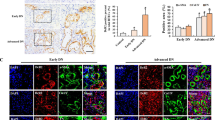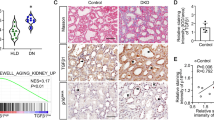Abstract
The receptor for advanced glycation endproduct (RAGE) is involved in diabetic complications and chronic inflammation, conditions known to affect the sensitivity towards apoptosis. Here, we studied the effect of genetically depleting RAGE on the susceptibility towards apoptosis. In murine osteoblastic cells, RAGE knockout increased both spontaneous and induced apoptosis. Decreased levels of B-cell lymphoma 2 protein and increased intrinsic apoptosis were observed in Rage−/− cells. Furthermore, loss of RAGE increased expression of the death receptor CD95 (Fas, Apo-1), CD95-dependent caspase activation and extrinsic apoptosis, whereas NF-kB-p65 nuclear translocation was diminished. Importantly, depletion of RAGE reduced the ubiquitination and degradation of p53 and p73 and increased their nuclear translocation. The increase of p53 and p73 transactivational activity was essential for the RAGE-dependent regulation of apoptosis, because knockdown of p53 and p73 significantly decreased apoptosis in RAGE-deficient but not in RAGE-expressing cells. Thus, the RAGE-mediated posttranslational regulation of p53 and p73 orchestrates a sequence of events culminating in control of intrinsic and extrinsic apoptosis signaling pathways.
This is a preview of subscription content, access via your institution
Access options
Subscribe to this journal
Receive 50 print issues and online access
$259.00 per year
only $5.18 per issue
Buy this article
- Purchase on Springer Link
- Instant access to full article PDF
Prices may be subject to local taxes which are calculated during checkout






Similar content being viewed by others
References
Neeper M, Schmidt AM, Brett J, Yan SD, Wang F, Pan YCE et al. Cloning and expression of a cell-surface receptor for advanced glycosylation end-products of proteins. J Biol Chem (1992); 267: 14998–15004.
Schmidt AM, Vianna M, Gerlach M, Brett J, Ryan J, Kao J et al. Isolation and characterization of 2 binding-proteins for advanced glycosylation end-products from bovine lung which are present on the endothelial-cell surface. J Biol Chem (1992); 267: 14987–14997.
Bierhaus A, Humpert PM, Morcos M, Wendt T, Chavakis T, Arnold B et al. Understanding RAGE, the receptor for advanced glycation end products. J Mol Med (2005); 83: 876–886.
Liliensiek B, Weigand MA, Bierhaus A, Nicklas W, Kasper M, Hofer S et al. Receptor for advanced glycation end products (RAGE) regulates sepsis but not the adaptive immune response. J Clin Invest (2004); 113: 1641–1650.
Bierhaus A, Nawroth PP . Multiple levels of regulation determine the role of the receptor for AGE (RAGE) as common soil in inflammation, immune responses and diabetes mellitus and its complications. Diabetologia (2009); 52: 2251–2263.
Ding KH, Wang ZZ, Hamrick MW, Deng ZB, Zhou L, Kang BL et al. Disordered osteoclast formation in RAGE-deficient mouse establishes an essential role for RAGE in diabetes related bone loss. Biochem Biophys Res Commun (2006); 340: 1091–1097.
Eggers K, Sikora K, Lorenz M, Taubert T, Moobed M, Baumann G et al. RAGE-dependent regulation of calcium-binding proteins S100A8 and S100A9 in human THP-1. Exp Clin Endocrinol Diabetes (2011); 119: 353–357.
Schmidt AM, Du Yan S, Yan SF, Stern DM . The multiligand receptor RAGE as a progression factor amplifying immune and inflammatory responses. J Clin Invest (2001); 108: 949–955.
Soro-Paavonen A, Watson AMD, Li J, Paavonen K, Koitka A, Calkin AC et al. Receptor for advanced glycation end products (RAGE) deficiency attenuates the development of atherosclerosis in diabetes. Diabetes (2008); 57: 2461–2469.
Sparvero LJ, Asafu-Adjei D, Kang R, Tang DL, Amin N, Im J et al. RAGE (receptor for advanced glycation endproducts), RAGE Ligands, and their role in Cancer and Inflammation. J Transl Med (2009); 7: 17.
Huttunen HJ, Kuja-Panula J, Sorci G, Agneletti AL, Donato R, Rauvala H . Coregulation of neurite outgrowth and cell survival by amphoterin and S100 proteins through receptor for advanced glycation end products (RAGE) activation. J Biol Chem (2000); 275: 40096–40105.
Taguchi A, Blood DC, del Toro G, Canet A, Lee DC, Qu W et al. Blockade of RAGE-amphoterin signalling suppresses tumour growth and metastases. Nature (2000); 405: 354–360.
Kang R, Tang D, Lotze MT, Zeh HJ . RAGE regulates autophagy and apoptosis following oxidative injury. Autophagy (2011); 7: 442–444.
Kang R, Tang D, Loze MT, Zeh HJ . Apoptosis to autophagy switch triggered by the MHC class III-encoded receptor for advanced glycation endproducts (RAGE). Autophagy (2011); 7: 91–93.
Alikhani M, Alikhani Z, Boyd C, MacLellan CM, Raptis M, Liu R et al. Advanced glycation end products stimulate osteoblast apoptosis via the MAP kinase and cytosolic apoptotic pathways. Bone (2007); 40: 345–353.
Barnes PJ, Larin M . Mechanisms of disease—Nuclear factor-kappa b—A pivotal transcription factor in chronic inflammatory diseases. N Eng J Med (1997); 336: 1066–1071.
Cheng B, Pan S, Liu X, Zhang S, Sun X . Cell apoptosis of taste buds in circumvallate papillae in diabetic rats. Exp Clin Endocrinol Diabetes (2011); 119: 480–483.
Ishihara K, Tsutsumi K, Kawane S, Nakajima M, Kasaoka T . The receptor for advanced glycation end-products (RAGE) directly binds to ERK by a D-domain-like docking site. FEBS Lett (2003); 550: 107–113.
Karin M . Nuclear factor-kappa B in cancer development and progression. Nature (2006); 441: 431–436.
Zhou Z, Immel D, Xi CX, Bierhaus A, Feng X, Mei L et al. Regulation of osteoclast function and bone mass by RAGE. J Exp Med (2006); 203: 1067–1080.
Paul RG, Bailey AJ . Glycation of collagen: the basis of its central role in the late complications of ageing and diabetes. Int J Biochem Cell Biol (1996); 28: 1297–1310.
Gulcelik NE, Bayraktar M, Caglar O, Alpaslan M, Karakaya J . Mortality after hip fracture in diabetic patients. Exp Clin Endocrinol Diabetes (2011); 119: 414–418.
Hofbauer LC, Brueck CC, Singh SK, Dobnig H . Osteoporosis in patients with diabetes mellitus. J Bone Miner Res (2007); 22: 1317–1328.
Stolzing A, Sellers D, Llewelyn O, Scutt A . Diabetes induced changes in rat mesenchymal stem cells. Cells Tissues Organs (2010); 191: 453–465.
Bentires-Alj M, Dejardin E, Viatour P, Van Lint C, Froesch B, Reed JC et al. Inhibition of the NF-kappa B transcription factor increases Bax expression in cancer cell lines. Oncogene (2001); 20: 2805–2813.
Kang R, Tang D, Schapiro NE, Livesey KM, Farkas A, Loughran P et al. The receptor for advanced glycation end products (RAGE) sustains autophagy and limits apoptosis, promoting pancreatic tumor cell survival. Cell Death Differ (2010); 17: 666–676.
Hiwatashi K, Ueno S, Kubo F, Sakoda M, Tateno T, Hayashi T et al. Relevance of apoptosis and tolerance to hypoxic stress in cells transfected with Receptor for Advanced Glycation End Products (RAGE). Anticancer Res (2009); 29: 1287–1294.
Chan H, Bartos DP, Owen-Schaub LB . Activation-dependent transcriptional regulation of the human fas promoter requires NF-kappa B p50-p65 recruitment. Mol Cell Biol (1999); 19: 2098–2108.
Lavrik IN, Golks A, Baumann S, Krammer PH . Caspase-2 is activated at the CD95 death-inducing signaling complex in the course of CD95-induced apoptosis. Blood (2006); 108: 559–565.
Seitz SJ, Schleithoff ES, Koch A, Schuster A, Teufel A, Staib F et al. Chemotherapy-induced apoptosis in hepatocellular carcinoma involves the p53 family and is mediated via the extrinsic and the intrinsic pathway. Int J Cancer (2010); 126: 2049–2066.
Lavrik IN, Golks A, Riess D, Bentele M, Eils R, Krammer PH . Analysis of CD95 threshold signaling—Triggering of CD95 (FAS/APO-1) at low concentrations primarily results in survival signaling. J Biol Chem (2007); 282: 13664–13671.
Gebhardt C, Riehl A, Durchdewald M, Nemeth J, Furstenberger G, Muller-Decker K et al. RAGE signaling sustains inflammation and promotes tumor development. J Exper Med (2008); 205: 275–285.
Miyashita T, Krajewski S, Krajewska M, Wang HG, Lin HK, Liebermann DA et al. Tumor suppressor p53 is a regulator of bcl-2 and bax gene expression in vitro and in vivo. Oncogene (1994); 9: 1799–1805.
Kikuchi H, Ozaki T, Furuya K, Hanamoto T, Nakanishi M, Yamamoto H et al. NF-kappa B regulates the stability and activity of p73 by inducing its proteolytic degradation through a ubiquitin-dependent proteasome pathway. Oncogene (2006); 25: 7608–7617.
Dudley E, Hornung F, Zheng L, Scherer D, Ballard D, Lenardo M . NF-kappaB regulates Fas/APO-1/CD95- and TCR- mediated apoptosis of T lymphocytes. Eur J Immunol (1999); 29: 878–886.
Rensing-Ehl A, Hess S, Ziegler-Heitbrock HW, Riethmuller G, Engelmann H . Fas/Apo-1 activates nuclear factor kappa B and induces interleukin-6 production. J Inflamm (1995); 45: 161–174.
Tsoporis JN, Izhar S, Leong-Poi H, Desjardins JF, Huttunen HJ, Parker TG . S100B interaction with the receptor for advanced glycation end products (RAGE): a novel receptor-mediated mechanism for myocyte apoptosis postinfarction. Circ Res (2010); 106: 93–101.
Constien R, Forde A, Liliensiek B, Grone HJ, Nawroth P, Hammerling G et al. Characterization of a novel EGFP reporter mouse to monitor Cre recombination as demonstrated by a Tie2 Cre mouse line. Genesis (2001); 30: 36–44.
Borcsok I, Schairer HU, Sommer U, Wakley GK, Schneider U, Geiger F et al. Glucocorticoids regulate the expression of the human osteoblastic endothelin A receptor gene. J Exper Med (1998); 188: 1563–1573.
Galluzzi L, Aaronson SA, Abrams J, Alnemri ES, Andrews DW, Baehrecke EH et al. Guidelines for the use and interpretation of assays for monitoring cell death in higher eukaryotes. Cell Death Differ (2009); 16: 1093–1107.
Muller M, Schilling T, Sayan AE, Kairat A, Lorenz K, Schulze-Bergkamen H et al. TAp73/Delta Np73 influences apoptotic response, chemosensitivity and prognosis in hepatocellular carcinoma. Cell Death Differ (2005); 12: 1564–1577.
Mundt HM, Stremmel W, Melino G, Krammer PH, Schilling T, Muller M . Dominant negative (DeltaN) p63alpha induces drug resistance in hepatocellular carcinoma by interference with apoptosis signaling pathways. Biochem Biophys Res Commun (2010); 396: 335–341.
Munsch D, Watanabe-Fukunaga R, Bourdon JC, Nagata S, May E, Yonish-Rouach E et al. Human and mouse Fas (APO-1/CD95) death receptor genes each contain a p53-responsive element that is activated by p53 mutants unable to induce apoptosis. J Biol Chem (2000); 275: 3867–3872.
Villa-Morales M, Santos J, Fernandez-Piqueras J . Functional Fas (Cd95/Apo-1) promoter polymorphisms in inbred mouse strains exhibiting different susceptibility to gamma-radiation-induced thymic lymphoma. Oncogene (2006); 25: 2022–2029.
Acknowledgements
We thank Dr Subrata Biswas for isolation of MOC, Thomas Fleming for assistance with chromatin immunoprecipitation and electroporation, Dr Andreas Koch for assistance with flow cytometry, as well as Katja Lorenz and Petra Hill for expert technical assistance. This work was supported by a grant of the Dietmar Hopp Stiftung ‘Altern—Mobilität erhalten, Regeneration ermöglichen’ to MB, PN, AB and TS, by a grant of the Deutsche Forschungsgemeinschaft SFB938 to AB and by the grant of the Deutsche Forschungsgemeinschaft, Transregional Collaborative Research Centre SFB/TRR77, the Tumorzentrum Heidelberg/Mannheim and the Helmholtz Alliance on Immunotherapy of Cancer funded by the Initiative and Networking Fund of the Helmholtz Association to MM.
Author information
Authors and Affiliations
Corresponding author
Ethics declarations
Competing interests
The authors declare no conflict of interest.
Additional information
Supplementary Information accompanies the paper on the Oncogene website .
Supplementary information
Rights and permissions
About this article
Cite this article
Brune, M., Müller, M., Melino, G. et al. Depletion of the receptor for advanced glycation end products (RAGE) sensitizes towards apoptosis via p53 and p73 posttranslational regulation. Oncogene 32, 1460–1468 (2013). https://doi.org/10.1038/onc.2012.150
Received:
Revised:
Accepted:
Published:
Issue Date:
DOI: https://doi.org/10.1038/onc.2012.150
Keywords
This article is cited by
-
Inhibition of the Receptor for Advanced Glycation End-Products (RAGE) Attenuates Neuroinflammation While Sensitizing Cortical Neurons Towards Death in Experimental Subarachnoid Hemorrhage
Molecular Neurobiology (2017)
-
The p53 tetramer shows an induced-fit interaction of the C-terminal domain with the DNA-binding domain
Oncogene (2016)



